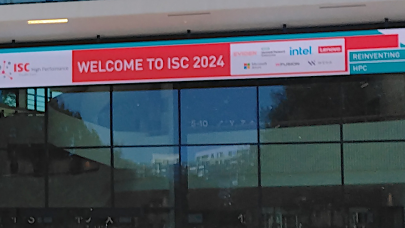Nov. 23, 2021 — This is a continuing profile series on the directors of the Department of Energy (DOE) Office of Science User Facilities. These scientists lead a variety of research institutions that provide researchers with the most advanced tools of modern science including accelerators, colliders, supercomputers, light sources and neutron sources, as well as facilities for studying the nano world, the environment, and the atmosphere.
Meet the director:

Since Gina Tourassi began her career, computer science has come a long way. Tourassi learned programming in the 1980s starting with QBasic. It’s a programming environment that hasn’t been included with Microsoft operating systems for more than 20 years. When she first discovered her love of computational research, computer scientists were programming artificial intelligence (AI) algorithms from scratch.
As a college physics student at the Aristotle University of Thessaloniki in Greece, Tourassi enjoyed applied math and physics courses. These courses pivoted her toward biomedical engineering for her graduate studies. In graduate school at Duke University, she realized a major passion for both research and computing. Tourassi decided to moveh3 into big data analytics, computational modeling, and AI for health care delivery. Tourassi spent 16 years in the Department of Radiology at the Duke University School of Medicine. Then she embarked upon a new adventure at Oak Ridge National Laboratory (ORNL), where she was hired to direct the Biomedical Sciences and Engineering Center.
Today Tourassi is the director of the National Center for Computational Sciences (NCCS) at ORNL. There, she is leading the center’s staff members in initiatives related to its world-class computing infrastructure programs and projects. These initiatives include the efforts to launch the nation’s first exascale system, the HPE Cray EX Frontier, which will be housed at ORNL. Exascale supercomputers will be capable of one quintillion calculations per second, or 1 with 18 zeroes. The NCCS hosts the Oak Ridge Leadership Computing Facility (OLCF), a DOE Office of Science user facility.
“I enjoy working side by side with NCCS staff members to deliver computing and data infrastructures for accelerated research and development,” Tourassi said. “We are giving the nation a significant advantage in the ever-changing scientific and economic landscape for open science, which makes every day meaningful.”
High-performance computing (HPC), or supercomputing, gives scientists the ability to model real-world situations at new levels of detail. It also helps them study areas that scientists can’t explore with experiment, observation, or theory alone. Computational scientists write complex mathematical formulas that can be carried out by these massive systems. The systems can then help provide solutions to some of the world’s most important problems. Using supercomputers, scientists can improve the safety and performance of nuclear power plants and aircraft. They accelerate the development of new drugs and advanced materials. They can even understand how the climate around the world is changing. Models on the OLCF’s supercomputers have explored hurricanes, fuels, diseases, and clean energy.
The director’s background:
After Tourassi completed her graduate studies at Duke University, she was awarded a postdoctoral position in the Department of Radiology at Duke University Medical Center. Within her first year, she received the National Institutes of Health Young Investigator Award, which launched her academic career. Over the next 16 years, Tourassi held positions as an assistant, associate, and then adjunct professor at Duke University School of Medicine.
In 2011, Tourassi joined ORNL as the director for the Biomedical Science and Engineering Center. She was hired to grow the research portfolio at ORNL. In 2013, she became the director of ORNL’s Health Data Sciences Institute. In 2019, only three months before the COVID-19 pandemic took hold of the United States, Tourassi became the NCCS director.
“I believe that personal and professional growth comes from taking risks, tackling new challenges, embracing change, and being comfortable with feeling uncomfortable,” Tourassi said. “The NCCS director position met many of the above criteria.”
Tourassi has also led the division as it has prepared for the installation and launch of the Frontier system. Frontier will offer best-in-class traditional scientific modeling and simulation capabilities while also leading the world in artificial intelligence and data analytics.
As director of the NCCS, Tourassi has continued to perform hands-on research. She currently leads the National Cancer Institute and DOE partnership, in addition to her role at the NCCS. The partnership is accelerating advances in predicting cancer using computing.
The facility:
The OLCF was established in 2004 to provide researchers from government, academia, and industry with access to leadership computing resources. At the time, individual programs received 100 times more computing power than what was available at other facilities.
From ORNL’s first Cray X-MP system deployed in the early 1980s to today’s 200-petaflop Summit supercomputer, the OLCF has seen more than a billionfold increase in computing power. The OLCF is now on the brink of delivering the first exascale system in the US, the 1.5-exaflop Frontier supercomputer. It will debut in 2021 and be available to users in 2022. The NCCS, a division of the Computing and Computational Sciences Directorate at ORNL, houses the OLCF.
“The OLCF—and, by extension, the NCCS—has been a global leader in HPC for nearly 30 years,” Tourassi said. “What we often forget when we talk about facilities such as the NCCS is that what makes them shine is not the technology they bring to bear but the caliber of the individuals who make it happen. These are individuals who not only have top-notch scientific and technical expertise but also unparalleled commitment to science and the national mission.”
Researchers can earn time on the OLCF systems, including Frontier, through three allocation programs: the INCITE (Innovative and Novel Computational Impact on Theory and Experiment) program, the ALCC (Advanced Scientific Computing Research Leadership Computing Challenge), and the Director’s Discretionary program.
Tourassi emphasized the diverse and unmatched capabilities that the NCCS and the OLCF afford. Both entities operate to fulfill a broad range of needs.
“The OLCF is unique in its ability to consistently answer the challenge of fielding and operating the nation’s fastest computer for open science,” Tourassi said. “The NCCS is unique in that we incorporate the OLCF into a larger HPC ecosystem that thinks more broadly and strategically to meet the nation’s compute and data needs.”
Tourassi pointed to some of the recent major successes of the OLCF’s current Summit system.
“Summit has helped the scientific community reach new heights in weather forecasting, gain new insights in materials, design efficient and durable jet engines, develop and deploy AI solutions for the national cancer surveillance program, and gain a better understanding of the coronavirus to guide vaccine development and drug targeting,” Tourassi said.
She said the upcoming Frontier system will bring even more advancements.

Exascale computing systems are capable of solving calculations more than five times faster than recent top supercomputers, exceeding a quintillion—or 1018—calculations per second. As the next level of computing performance, exascale will enable scientists to develop critically needed technologies for energy, medicine, materials, and more. The OLCF is launching one of America’s first exascale systems: the 1.5-exaflop HPE Cray EX Frontier supercomputer, a Cray system based on the Shasta Slingshot architecture and featuring AMD EPYC CPUs and AMD Radeon Instinct GPUs. For more information, please see “DOE Explains…Exascale Computing.”
Typical day:
Tourassi’s day consists of back-to-back meetings. They range from the various computing programs that the division leads, to personnel management, to the research projects she continues to lead.
“I also enjoy the regular one-on-one meetings I hold with the section heads and group leaders, which I consider important to staying connected with them, discussing challenges they face, and supporting them in achieving their goals,” Tourassi said.
Typical experiment:
The OLCF supports a broad range of scientific projects in many areas, such as biology, chemistry, geosciences, engineering, and energy. The OLCF offers researchers computing and data analysis resources many times more powerful than what they could access elsewhere.

One project that the OLCF supports involves the study of superconductors. These are materials that have zero electrical resistance when they reach sufficiently low temperatures. Superconductors might be useful for technologies such as magnets for MRIs, fusion devices, and particle accelerators. A team led by Lawrence Berkeley National Laboratory’s Steven Louie and Zhenglu Li is studying copper-based superconductors to understand the interactions between negatively charged particles and the other particles in these materials. The team modeled materials on Summit and found that the negatively charged particles in these materials interact with quantum waves of vibrational motions much more strongly than was previously thought. That led to experimentally observed “kinks,” or sudden changes, in the relationship between a particle’s energy and the momentum it carries.
Another project built a workflow based on AI to more efficiently simulate the SARS-CoV-2 virus’ protein spike. Then the team, led by University of California San Diego’s Rommie Amaro and Argonne National Laboratory’s Arvind Ramanathan, ran the workflow on Summit to gain a deeper understanding of the spike and accelerate the search for medications or vaccines that might mitigate the spread of the virus or lessen its impact. The team simulated the SARS-CoV-2 virus’ spike in numerous environments, including within the SARS-CoV-2 viral envelope made of 305 million atoms. It was one of the most comprehensive simulations of the virus performed to date. The team was awarded the Association for Computing Machinery Gordon Bell Special Prize for HPC-Based COVID-19 Research for the work.
Best advice for a future director at the OLCF:
Tourassi said that success at the NCCS requires strategic thinking, not only in regard to the short-term requirements and deliverables, but also when thinking about the long-term computational and data needs of the scientific community. She said that the NCCS has a reputation of delivering some of the most unparalleled computing infrastructure for scientific research but that it can’t rely on past successes. Just as science is always advancing, the center’s computational tools and capabilities must be ever-evolving to meet emerging needs.
As far as advice to a future successor, Tourassi said: “It is important to understand that the role is to think strategically. We need to remain ever mindful and proactive in expanding our portfolio of capabilities by anticipating the scientific community’s computational needs. The DOE Leadership Computing Facilities are a disruptive force. They shape the way we think about and do science.”
DOE’s Office of Science. UT-Battelle LLC manages Oak Ridge National Laboratory for DOE’s Office of Science, the single largest supporter of basic research in the physical sciences in the United States. DOE’s Office of Science is working to address some of the most pressing challenges of our time. For more information, visit https://energy.gov/science.
Source: Oak Ridge National Laboratory
























































